本文转自 IEA(International Energy Agency)发布的题为“Tracking Clean Energy Progress”的报道。
原文链接:https://www.iea.org/tcep/
The IEA’s newly-enhanced Tracking Clean Energy Progress provides a comprehensive and rigorous assessment of a full range of energy technologies and sectors that are critical in a global clean-energy transition. It includes the most up-to-date information for where technologies are today and where they need to be according to the IEA’s Sustainable Development Scenario, a pathway to reach the Paris Agreement well below 2°C climate goal, deliver universal energy access and significantly lower air pollution.
国际能源署新增加的“跟踪清洁能源进展”在全球范围内对全球清洁能源转型至关重要的能源技术和部门进行全面和严格的评估。 它包括最新的技术信息,以及他们需要根据国际能源署的可持续发展(SDS)情景确定的最新信息,这是实现“巴黎协议”远低于2°C气候目标的途径,能够提供全面的能源通道,降低空气污染。
Are clean energy technologies on track with a well below 2°C scenario?
清洁能源技术在追踪远低于2°C的方案吗?
Some technologies have made tremendous progress in 2017 – particularly solar PV, LEDs and EVs – but most are not on track. Energy efficiency improvements have slowed and progress on key technologies like carbon capture and storage remains stalled.
一些技术在2017年取得了巨大进步 - 特别是太阳能光伏,LED和电动汽车 - 但大多数都没有按计划进行。 能源效率的提高已经放缓,碳捕集和封存等关键技术的进展仍然停滞不前。
The way ahead: a rapid transformation of the energy system
未来之路:能源体系的快速转变
The Sustainable Development Scenario depicts a rapid but achievable transformation of the energy sector. Meeting long-term sustainability goals requires an ambitious combination of more energy efficient buildings, industry and transport, and more renewables and flexibility in power. Based on existing and announced policies – as described in the IEA New Policies Scenario – the world is not on course to achieve these goals.
可持续发展情景描述了能源部门的一个快速但可实现的转变。 要实现长期的可持续发展目标,需要将更多的节能建筑,工业和运输,更多的可再生能源和灵活的动力结合起来。 根据现有的和宣布的政策 - 如IEA新政策情景中所述 - 世界当然不会实现这些目标。
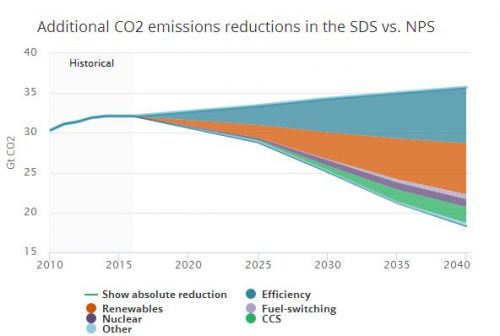
各种清洁能源额外减少CO2排放量
How energy sectors can contribute to the decarbonisation effort
能源部门如何为低碳做出贡献
Decarbonising the power sector is a fundamental step to reducing emissions. It must be complemented by unprecedented efficiency improvements in buildings, addressing growing demand from cooling, heating and powered devices. The transport sector will need to undergo a major transformation, including shifts from oil to electricity to reap the benefits of clean power generation. Industry processes that can't be easily electrified must cut emissions through efficiency, aggressive innovation and carbon capture. And energy integration technologies will become increasingly important as shares of variable renewables rise.
减少电力部门是减少排放的一个基本步骤。 必须辅之以空前的建筑效率改进,满足冷却,加热和供电设备日益增长的需求。 运输部门需要进行重大转型,包括从石油转向电力,以获得清洁发电的好处。 不易通电的工业过程必须通过效率,积极的创新和碳捕获来减少排放。 随着可变能源可再生能源份额的上升,能源集成技术将变得越来越重要。
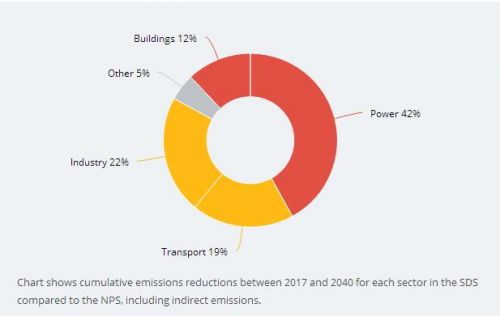
图表显示了SDS(可持续发展情况)与NPS(不可持续情况)相比在2017年至2040年间每个行业的累计减排量,包括间接排放量。
The critical importance of public and private innovation
公共和个人创新至关重要
The IEA's most timely and comprehensive data ever indicates a very welcome 13% increase in 2017 for public innovation investment in clean energy technologies, breaking a streak of declines and stagnation over several years. Private-sector clean energy innovation grew by 4% in 2017. IEA’s new Innovation Tracking Framework identifies more than 100 key technology gaps that need to be addressed to meet clean transition goals.
国际能源署最新和最全面的数据显示,2017年清洁能源技术的公共创新投资增长率为13%,在几年内出现下滑和停滞。 2017年,私营部门的清洁能源创新增长了4%。国际能源署的新创新追踪框架确定了需要解决的100多个关键技术差距,以实现清洁转型目标。
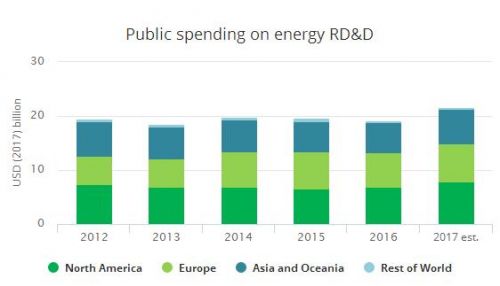
能源研发的公共开支
Is the energy system on track?
能源系统正在轨道上吗?
The IEA has prepared a set of key indicators that reflect the most important short-term actions that policymakers should focus on to drive the clean energy transition.
国际能源署编制了一套关键指标,反映了决策者应该关注的推动清洁能源转型的最重要的短期行动。
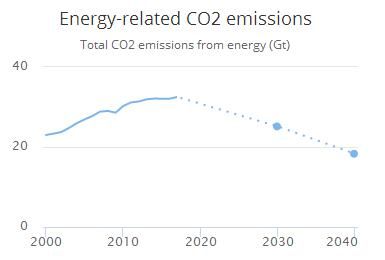
能源相关的CO2排放(总CO2排放)
The overall trend of decoupling economic growth from energy-related CO2emissions continues despite a disappointing 1.4% increase in emissions in 2017.
尽管2017年排放量增加了1.4%,但经济增长与能源相关二氧化碳排放脱钩的整体趋势仍在继续。
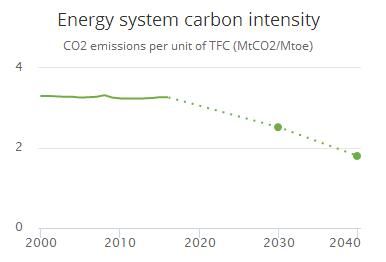
能源强度,单位GDP的能源需求
The improvement in energy intensity slowed down in 2017 due to weaker efficiency policies and low energy prices.
由于效率政策和能源价格低迷,2017年能源强度的改善放缓。
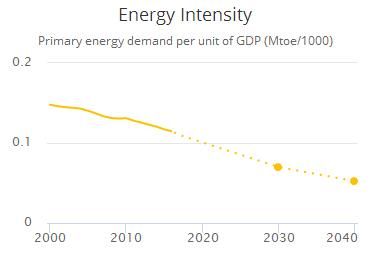
能源系统碳强度,单位TFC的碳排放
There are signs that global energy supply has become cleaner over the past few years, but faster improvements are needed.
有迹象表明,过去几年全球能源供应已经变得更加清洁,但需要更快的改善。
The view from the analysts
分析师的看法
"There is a critical need for more vigorous action by governments, industry, and other stakeholders to drive advances in energy technologies that reduce greenhouse gas emissions.The world doesn’t have an energy problem but an emissions problem and this is where we should focus our efforts.”
“迫切需要政府,行业和其他利益相关方采取更积极的行动来推动减少温室气体排放的能源技术的进步。世界没有能源问题,而是排放问题,这是我们应该关注的问题 我们的努力。”